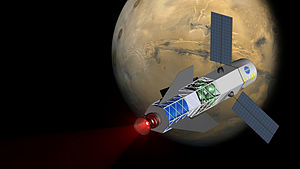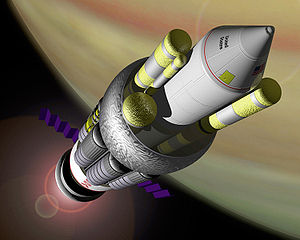An artist's conception of the Project Orion "basic" spacecraft, powered by nuclear pulse propulsion.
Nuclear pulse propulsion or external pulsed plasma propulsion is a hypothetical method of spacecraft propulsion that uses nuclear explosions for thrust. It was first developed as Project Orion by DARPA, after a suggestion by Stanislaw Ulam in 1947. Newer designs using inertial confinement fusion have been the baseline for most post-Orion designs, including Project Daedalus and Project Longshot.
Project Orion
A nuclear pulse propulsion unit. The explosive charge ablatively vaporizes
the propellant, propelling it away from the charge, and simultaneously
creating a plasma out of the propellant. The propellant then goes on to
impact the pusher plate at the bottom of the Orion spacecraft, imparting
a pulse of 'pushing' energy.
Project Orion was the first serious attempt to design a nuclear pulse rocket. The design effort was carried out at General Atomics in the late 1950s and early 1960s. The idea of Orion was to react small directional nuclear explosives utilizing a variant of the Teller-Ulam
two-stage bomb design against a large steel pusher plate attached to
the spacecraft with shock absorbers. Efficient directional explosives
maximized the momentum transfer, leading to specific impulses in the range of 6,000 seconds, or about thirteen times that of the Space Shuttle main engine. With refinements a theoretical maximum of 100,000 seconds (1 MN·s/kg) might be possible. Thrusts were in the millions of tons, allowing spacecraft larger than 8×106 tons to be built with 1958 materials.
The reference design
was to be constructed of steel using submarine-style construction with a
crew of more than 200 and a vehicle takeoff weight of several thousand tons.
This low-tech single-stage reference design would reach Mars and back in
four weeks from the Earth's surface (compared to 12 months for NASA's
current chemically powered reference mission). The same craft could
visit Saturn's moons in a seven-month mission (compared to chemically
powered missions of about nine years).
A number of engineering problems were found and solved over the
course of the project, notably related to crew shielding and
pusher-plate lifetime. The system appeared to be entirely workable when
the project was shut down in 1965, the main reason being given that the Partial Test Ban Treaty
made it illegal (however, before the treaty, the US and Soviet Union
had already detonated at least nine nuclear bombs, including
thermonuclear bombs, in space, i.e., at altitudes over 100 km: see high-altitude nuclear explosions). There were also ethical issues with launching such a vehicle within the Earth's magnetosphere: calculations using the now disputed linear no-threshold model of radiation damage showed that the fallout from each takeoff would kill between 1 and 10 people.
In a threshold model, such extremely low levels of thinly distributed
radiation would have no associated ill-effects, while under hormesis
models, such tiny doses would be negligibly beneficial. With the possible use of less efficient clean nuclear bombs
for achieving orbit and then more efficient higher yield dirty bombs
for travel would bring down the amount of fallout caused from an
Earth-based launch by a significant factor.
One useful mission for this
near-term technology would be to deflect an asteroid that could collide
with the Earth, depicted dramatically in the 1998 film Deep Impact,
even though it was a comet in that particular film. The extremely high
performance would permit even a late launch to succeed, and the vehicle
could effectively transfer a large amount of kinetic energy to the
asteroid by simple impact, and in the event of an imminent asteroid impact a few predicted deaths from fallout
would probably not be considered prohibitive. Also, an automated
mission would eliminate the most problematic issues of the design: the
shock absorbers.
Orion is one of very few interstellar space drives that could
theoretically be constructed with available technology, as discussed in a
1968 paper, Interstellar Transport by Freeman Dyson.
Project Daedalus
Project Daedalus was a study conducted between 1973 and 1978 by the British Interplanetary Society
(BIS) to design a plausible interstellar unmanned spacecraft that could
reach a nearby star within one human scientist's working lifetime or
about 50 years. A dozen scientists and engineers led by Alan Bond worked on the project. At the time fusion research appeared to be making great strides, and in particular, inertial confinement fusion (ICF) appeared to be adaptable as a rocket engine.
ICF uses small pellets of fusion fuel, typically lithium deuteride (6Li2H) with a small deuterium/tritium trigger at the center. The pellets are thrown into a reaction chamber where they are hit on all sides by lasers
or another form of beamed energy. The heat generated by the beams
explosively compresses the pellet, to the point where fusion takes
place. The result is a hot plasma,
and a very small "explosion" compared to the minimum size bomb that
would be required to instead create the necessary amount of fission.
For Daedalus, this process was run within a large electromagnet
which formed the rocket engine. After the reaction, ignited by electron
beams in this case, the magnet funnelled the hot gas to the rear for
thrust. Some of the energy was diverted to run the ship's systems and
engine. In order to make the system safe and energy efficient, Daedalus
was to be powered by a helium-3 fuel that would have had to be collected from Jupiter.
Medusa
Conceptual diagram of a Medusa propulsion spacecraft, showing: (A) the payload capsule, (B) the winch mechanism, (C) the optional main tether cable, (D) riser tethers, and (E) the parachute mechanism.
Operating sequence of the Medusa propulsion system. This diagram shows the operating sequence of a Medusa propulsion spacecraft (1) Starting at moment of explosive-pulse unit firing, (2) As the explosive pulse reaches the parachute canopy, (3)
Pushes the canopy, accelerating it away from the explosion as the
spacecraft plays out the main tether with the winch, generating
electricity as it extends, and accelerating the spacecraft, (4) And finally winches the spacecraft forward to the canopy and uses excess electricity for other purposes.
The Medusa design is a type of nuclear pulse propulsion which has more in common with solar sails than with conventional rockets. It was envisioned by Johndale Solem in the 1990s and published in the Journal of the British Interplanetary Society (JBIS).
A Medusa spacecraft would deploy a large "spinnaker" sail
ahead of it, attached by separate independent cables, and then launch
nuclear explosives forward to detonate between itself and its sail. The
sail would be accelerated by the plasma and photonic impulse, running
out the tethers as when a fish flees the fisherman, and generating
electricity at the "reel". The spacecraft would then use some of the
generated electricity to reel itself up towards the sail, constantly
smoothly accelerating as it goes.
In the original design, multiple tethers connected to multiple
motor generators. The advantage over the single tether is to increase
the distance between the explosion and the tethers, thus reducing damage
to the tethers.
For heavy payloads, performance could be improved by taking
advantage of lunar materials, for example, wrapping the explosive with
lunar rock or water, likely stored previously at a stable Earth-Moon Lagrange point to be subsequently acquired by the Medusa spacecraft.
Medusa performs better than the classical Orion design
because its sail intercepts more of the explosive impulse, its
shock-absorber stroke is much longer, and all its major structures are
in tension and hence can be quite lightweight. Medusa-type ships would be capable of a specific impulse between 50,000 and 100,000 seconds (500 to 1000 kN·s/kg).
Medusa is widely known to the public in the BBC documentary film To Mars By A-Bomb: The Secret History of Project Orion. A short film shows an artist's conception of how the Medusa spacecraft works "by throwing bombs into a sail that's ahead of it".
Project Longshot
Project Longshot was a NASA-sponsored research project carried out in conjunction with the US Naval Academy in the late 1980s. Longshot
was in some ways a development of the basic Daedalus concept, in that
it used magnetically funneled ICF as a rocket. The key difference was
that they felt that the reaction could not power both the rocket and the
systems, and instead included a 300 kW conventional nuclear reactor
for running the ship. The added weight of the reactor reduced
performance somewhat, but even using LiD fuel it would be able to reach Alpha Centauri,
the closest solar system to our own, in 100 years (approx. velocity of
13,411 km/s, at a distance of 4.5 light years - equivalent to 4.5% of
light speed).
Antimatter-catalyzed nuclear pulse propulsion
In the mid-1990s research at the Pennsylvania State University led to the concept of using antimatter to catalyze nuclear reactions. In short, antiprotons would react inside the nucleus of uranium,
causing a release of energy that breaks the nucleus apart as in
conventional nuclear reactions. Even a small number of such reactions
can start the chain reaction that would otherwise require a much larger volume of fuel to sustain. Whereas the "normal" critical mass for plutonium
is about 11.8 kilograms (for a sphere at standard density), with
antimatter catalyzed reactions this could be well under one gram.
Several rocket designs using this reaction were proposed, some
which would use all-fission reactions for interplanetary missions, and
others using fission-fusion (effectively a very small version of Orion's
bombs) for interstellar missions.
MSNW magneto-inertial fusion driven rocket

Concept graphic of a fusion-driven rocket powered spacecraft arriving at Mars
| |
| Designer | MSNW LLC |
|---|---|
| Application | Interplanetary |
| Status | Theoretical |
| Performance | |
| Specific impulse | 1,606 s to 5,722 s (depending on fusion gain) |
| Burn time | 1 day to 90 days (10 days optimal with gain of 40) |
| References | |
| References | |
| Notes |
|
NASA funded MSNW LLC and the University of Washington in 2011 to study and develop a fusion rocket through the NASA Innovative Advanced Concepts NIAC Program.
The rocket uses a form of magneto-inertial fusion
to produce a direct thrust fusion rocket. Powerful magnetic fields
cause large metal rings (likely made of lithium, where a set for one
pulse has a total mass of 365 grams) to collapse around the deuterium-tritium
plasma, compressing it to a fusion state. Energy from these fusion
reactions heats and ionizes the shell of metal formed by the crushed
rings. The hot, ionized metal is shot out of a magnetic rocket nozzle at
a high speed (up to 30 km/s). Repeating this process roughly every
minute would propel the spacecraft.
The fusion reaction is not self-sustaining and requires electrical
energy to induce fusion. With electrical requirements estimated to be
between 100 kW to 1,000 kW (300 kW average), spacecraft designs
incorporate solar panels to produce the electrical energy needed for the
fusion engine.
This approach uses Foil Liner Compression to create a fusion
reaction of the proper energy scale to be used for space propulsion. The
proof of concept experiment in Redmond, Washington, will use aluminum
liners for compression. However, the actual rocket design will run with
lithium liners.
The performance characteristics of the engine are highly dependent on the Fusion energy gain factor
achieved by the reactor. Gains are expected to be between a factor of
20 and 200, with an estimated average of 40. With higher fusions gains
comes higher exhaust velocity, higher specific impulse and lower
electrical power requirements. The table below summarizes different
performance characteristics for a theoretical 90-day Mars transfer at
gains of 20, 40 and 200.
| Total gain | Gain 20 | Gain 40 | Gain 200 |
|---|---|---|---|
| Liner mass (kg) | 0.365 | 0.365 | 0.365 |
| Specific impulse (s) | 1,606 | 2,435 | 5,722 |
| Mass fraction | 0.33 | 0.47 | 0.68 |
| Specific mass (kg/kW) | 0.8 | 0.53 | 0.23 |
| Mass propellant (kg) | 110,000 | 59,000 | 20,000 |
| Mass initial (kg) | 184,000 | 130,000 | 90,000 |
| Electrical power required (kW) |
1,019 | 546 | 188 |
By April 2013, MSNW had demonstrated subcomponents of the systems: heating deuterium plasma
up to fusion temperatures and have concentrated the magnetic fields
needed to create fusion. They planned to put the two technologies
together for a test before the end of 2013.
They could later be scaled up in power and plan to add the necessary fusion fuel (deuterium) by the end (Sept 2014) of the NIAC Study.










